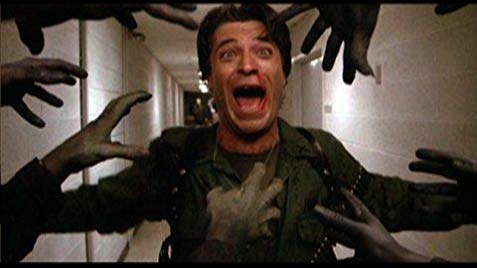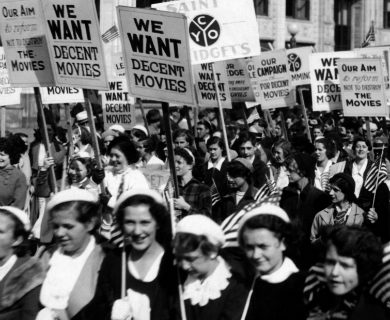Early in George A. Romero’s brilliant 2005 film Land of the Dead, a scavenger party is out looking for essential supplies for their post-apocalyptic settlement in the Golden Triangle area of Pittsburgh when they happen to notice something rather unusual: zombies behaving like, well, people. One gas station attendant in particular catches their eye, emerging from the gas station and heading to the pump after hearing a full-service bell. A young member of the party observes, “They’re pretending to be alive,” to which the team’s leader retorts, “Isn’t that what we’re doing? Pretending to be alive?” The television series The Walking Dead hasalso touched on a similar idea: what is it, exactly, that separates the living from the undead? Is it not the shell-shocked and often purposeless humans who are in some ways more like the living dead?
Visiting many of the hollowed-out, post-industrial wastelands that increasingly define places like the Midlands in the UK or the Rust Belt in the United States is like stepping into a scene straight from Romero: countless aimless, shuffling, and tattered people, often narcotized into oblivion, zombie-like and totally listless. Dead behind the eyes and living for nothing but their next fix. There is virtually no difference between these breathing tragedies and the fictitious ambulatory corpses.
It’s not just the visually-striking addicts whose fates are like a living death. Think of the countless millions of others hooked on and numbed by all kinds of substances, psychopharmaceuticals, mindless entertainment, pornography, and video games. What is a zombie, after all, but a mindless consumer? It lurches ever-forward in search of its prey: human flesh to gorge itself upon. The zombie does not need the flesh it hunts in order to survive, in the same way that the addict does not need that which they crave, that which, in a dark irony, is ultimately what consumes them. What kind of life is that? No life at all it would seem. The zombie is purely mechanized instinct, the human vessel transformed into a voracious abomination. The zombie is not a natural phenomenon. It is a harbinger of destruction.
Several of Romero’s films contain very sharp and deftly-handled critiques of capitalism, and both Dawn of the Dead (1978) and Land of the Dead may be viewed allegorically in this same vein. While Dawn of the Dead’s setting in a mall besieged by ravenous zombies pounding at the doors to get in plainly telegraphs to the viewer its harsh critique of consumer capitalism—one exchange occurs when the character Fran, while looking out at the zombies asks Flyboy, “Why do they come here?” to which he responds, “Some kind of instinct. Memory, of what they used to do. This was an important place in their lives.”—Land of the Dead works on multiple levels, which is not to say that Dawn’s critique is not well-executed, but rather that the social conditions in the elapsed time between the two films had changed.
1985’s Day of the Dead imagines a world almost totally overrun by the undead, and one of the opening shots shows a bunch of dollar bills blowing down an abandoned and decimated South Florida street, offering a similar critique to the real-money-as-play-money shopping spree scene in Dawn. In this new world, money is worthless. Given the state of affairs, lives led in pursuit of obtaining an excess of it to acquire more consumer products and status symbols rings all the more hollowly when juxtaposed with both the availability of everything for the taking and the omnipresent threat of hordes of zombies. What truly matters comes sharply into focus.
Land is in the same “universe” as the preceding three films—Night of the Living Dead (1968), Dawn of the Dead, and Day of the Dead—but is further still in the future. What can best be described as an anarcho-capitalist’s dream defines the squalid street-level existence for the majority of the people in the Golden Triangle community of survivors, distracted by vulgar amusements, cheap junk, and booze. The community is protected on two sides by a river and the third by a militia and fortifications. That is the only protection the majority really have, and one has to wonder if life inside is any better than life—or death for that matter—outside. A massive high rise called Fiddler’s Green dominates the community, and at its top, literally and metaphorically, is merchant and de facto kingpin Paul Kaufman. The viewer cannot help but see Kaufman as the archetypal neo-conservative, especially when he bellows that, “We do not negotiate with terrorists!” As with Night of the Living Dead, borrowing from Tony Williams, “the film is inextricably related to its historical context,” consequently evoking the viewer’s associations with history and with the present.
When Dawn of the Dead was released, the neo-liberal system was just starting to predominate and had not yet achieved its fully realized form, but nearly three decades later, around the release of Land of the Dead, it most certainly had. The realities had changed and become, it might be said, far more horrific. These find expression in Land of the Dead, although this “living” version of neo-liberalism had not yet become what it is now: the Zombie System, the shambolic and ravenous post-crash neo-liberal corpse back from the dead.

Enjoy the Cocktail Hour podcast and other Dissident Right content at theanatomicallycorrectbanana.com.






Fascinating take on Romero’s “Dead” series if films. Silly me just looked at them as better than average horror flicks.